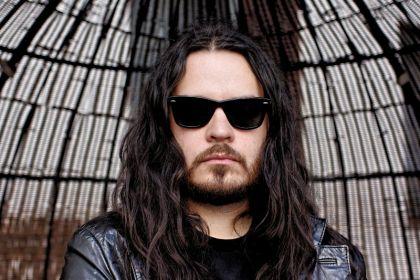Stamina is involved when you take in every concert at the WNMF, and perhaps naps, and also careful planning, especially if you have a kid at home who has eaten up all the Mini-Wheats and needs some more. But the audience dedication, you remind yourself, is nothing when compared to the fact that members of the orchestra have learned twenty new major compositions, many scored rather strangely; rehearsed them relatively briefly; and then turned up, night after night, working through every piece of black clothing in their own wardrobes and their friends’ and relatives’ wardrobes too.
“Give yourself to it,” was the gentle advice Stephen O’Malley (pictured) offered before his drone work on January 29, Un vide dan le ciel. That could apply to the entire WNMF experience, and I was especially amazed this week by two things. One is that (I think) hundreds of people stood up when asked on Sunday night if they had attended all twenty-five New Music Festivals here in Winnipeg. The other is that, after a week of listening to challenging experimental work, the music was beginning to sound natural to me. Instead I found myself thinking with some suspicion about standard classical works which formerly offered comfort or inspiration. I used to wonder, skeptically, if new music wasn’t just about chasing sound. But last night I asked myself: How do you know that Schubert or Prokofiev wasn’t “just” chasing sound? What does “just” chasing sound mean? And what if conventional beauty truly isn’t enough?
Stephen O’Malley’s primal and immersive music is courageous in its apparent simplicity and its endeavour to propel us beyond what we think of as normal reason and aesthetics. This orchestral performance was, surprisingly, too subtle, especially if you had encountered his riveting, bone-shaking solo show the previous night at Union Sound Hall. While conductor Alexander Mickelthwate demonstrated thoughtful commitment to this brand-new orchestral composition, it was the scoring that made me pause. The sound was too delicate, not tense enough. O’Malley’s work is serious and enormous in its sonic impact, but Un vide dan le ciel felt somewhat tentative. It should, instead, invoke both crisis and cure.
The final work of the festival, Henryk Górecki’s Symphony No. 4, did feel urgent and enormous, appropriate since he died in 2010 while it was still on the table. (His son Mikolaj completed the orchestration.) As in the composer’s most famous work, Symphony of Sorrowful Songs from 1976, there’s a haunting darkness, especially in the cello writing, that is unmistakable. This new symphony is simultaneously clamorous and mournful; and it’s intriguing how very Polish it sounds. Much new music is beyond borders, and Górecki’s work has certainly found a worldwide audience, especially in its insistence that ancient questions of faith remain vibrant. But still: the fourth symphony is resolutely a Polish work.
There wasn’t anything on the festival that I disliked, and the overall impression was of new views of beauty. If our old musical questions – will it resolve? what does this repetition mean? where is this momentum going? – still bother you after a week of stimulating new compositions, then possibly the New Music Festival isn’t for you. (Anyway, sometimes it does resolve, and maybe you should get over yourself.) For me, the notion I had while listening to Stephen O’Malley – this is both crisis and cure – felt like a way forward.
Sue Sorensen teaches English at Canadian Mennonite University and has lots of black outfits to loan to members of the Winnipeg Symphony Orchestra.
